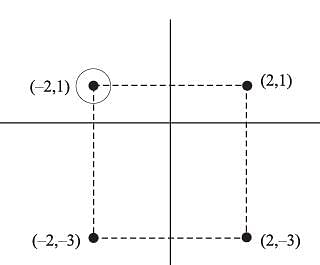ACT Exam > ACT Questions > In the standard (x, y) coordinate plane, if a...
Start Learning for Free
In the standard (x, y) coordinate plane, if a square has the vertices (−2,−3), (2,−3), and (2,1), what is the set of coordinates for the final vertex?
- a)(2,−1)
- b)(1,−2)
- c)(-1, 2)
- d)(-2,−1)
- e)(-2,1)
Correct answer is option 'E'. Can you explain this answer?
Verified Answer
In the standard (x, y) coordinate plane, if a square has the vertices ...
The correct answer is K. To solve this problem it might be helpful to draw a picture like the one below.

Since the figure is a square, the placement of the missing point becomes clear: the upper left corner. The point will share the same x-coordinate as (−2,−2) and the same y-coordinate as (2,1), making its coordinates (−2,1).

Since the figure is a square, the placement of the missing point becomes clear: the upper left corner. The point will share the same x-coordinate as (−2,−2) and the same y-coordinate as (2,1), making its coordinates (−2,1).

|
Explore Courses for ACT exam
|

|
Similar ACT Doubts
In the standard (x, y) coordinate plane, if a square has the vertices (−2,−3), (2,−3), and (2,1), what is the set of coordinates for the final vertex?a)(2,−1)b)(1,−2)c)(-1, 2)d)(-2,−1)e)(-2,1)Correct answer is option 'E'. Can you explain this answer?
Question Description
In the standard (x, y) coordinate plane, if a square has the vertices (−2,−3), (2,−3), and (2,1), what is the set of coordinates for the final vertex?a)(2,−1)b)(1,−2)c)(-1, 2)d)(-2,−1)e)(-2,1)Correct answer is option 'E'. Can you explain this answer? for ACT 2025 is part of ACT preparation. The Question and answers have been prepared according to the ACT exam syllabus. Information about In the standard (x, y) coordinate plane, if a square has the vertices (−2,−3), (2,−3), and (2,1), what is the set of coordinates for the final vertex?a)(2,−1)b)(1,−2)c)(-1, 2)d)(-2,−1)e)(-2,1)Correct answer is option 'E'. Can you explain this answer? covers all topics & solutions for ACT 2025 Exam. Find important definitions, questions, meanings, examples, exercises and tests below for In the standard (x, y) coordinate plane, if a square has the vertices (−2,−3), (2,−3), and (2,1), what is the set of coordinates for the final vertex?a)(2,−1)b)(1,−2)c)(-1, 2)d)(-2,−1)e)(-2,1)Correct answer is option 'E'. Can you explain this answer?.
In the standard (x, y) coordinate plane, if a square has the vertices (−2,−3), (2,−3), and (2,1), what is the set of coordinates for the final vertex?a)(2,−1)b)(1,−2)c)(-1, 2)d)(-2,−1)e)(-2,1)Correct answer is option 'E'. Can you explain this answer? for ACT 2025 is part of ACT preparation. The Question and answers have been prepared according to the ACT exam syllabus. Information about In the standard (x, y) coordinate plane, if a square has the vertices (−2,−3), (2,−3), and (2,1), what is the set of coordinates for the final vertex?a)(2,−1)b)(1,−2)c)(-1, 2)d)(-2,−1)e)(-2,1)Correct answer is option 'E'. Can you explain this answer? covers all topics & solutions for ACT 2025 Exam. Find important definitions, questions, meanings, examples, exercises and tests below for In the standard (x, y) coordinate plane, if a square has the vertices (−2,−3), (2,−3), and (2,1), what is the set of coordinates for the final vertex?a)(2,−1)b)(1,−2)c)(-1, 2)d)(-2,−1)e)(-2,1)Correct answer is option 'E'. Can you explain this answer?.
Solutions for In the standard (x, y) coordinate plane, if a square has the vertices (−2,−3), (2,−3), and (2,1), what is the set of coordinates for the final vertex?a)(2,−1)b)(1,−2)c)(-1, 2)d)(-2,−1)e)(-2,1)Correct answer is option 'E'. Can you explain this answer? in English & in Hindi are available as part of our courses for ACT.
Download more important topics, notes, lectures and mock test series for ACT Exam by signing up for free.
Here you can find the meaning of In the standard (x, y) coordinate plane, if a square has the vertices (−2,−3), (2,−3), and (2,1), what is the set of coordinates for the final vertex?a)(2,−1)b)(1,−2)c)(-1, 2)d)(-2,−1)e)(-2,1)Correct answer is option 'E'. Can you explain this answer? defined & explained in the simplest way possible. Besides giving the explanation of
In the standard (x, y) coordinate plane, if a square has the vertices (−2,−3), (2,−3), and (2,1), what is the set of coordinates for the final vertex?a)(2,−1)b)(1,−2)c)(-1, 2)d)(-2,−1)e)(-2,1)Correct answer is option 'E'. Can you explain this answer?, a detailed solution for In the standard (x, y) coordinate plane, if a square has the vertices (−2,−3), (2,−3), and (2,1), what is the set of coordinates for the final vertex?a)(2,−1)b)(1,−2)c)(-1, 2)d)(-2,−1)e)(-2,1)Correct answer is option 'E'. Can you explain this answer? has been provided alongside types of In the standard (x, y) coordinate plane, if a square has the vertices (−2,−3), (2,−3), and (2,1), what is the set of coordinates for the final vertex?a)(2,−1)b)(1,−2)c)(-1, 2)d)(-2,−1)e)(-2,1)Correct answer is option 'E'. Can you explain this answer? theory, EduRev gives you an
ample number of questions to practice In the standard (x, y) coordinate plane, if a square has the vertices (−2,−3), (2,−3), and (2,1), what is the set of coordinates for the final vertex?a)(2,−1)b)(1,−2)c)(-1, 2)d)(-2,−1)e)(-2,1)Correct answer is option 'E'. Can you explain this answer? tests, examples and also practice ACT tests.

|
Explore Courses for ACT exam
|

|
Signup for Free!
Signup to see your scores go up within 7 days! Learn & Practice with 1000+ FREE Notes, Videos & Tests.


























